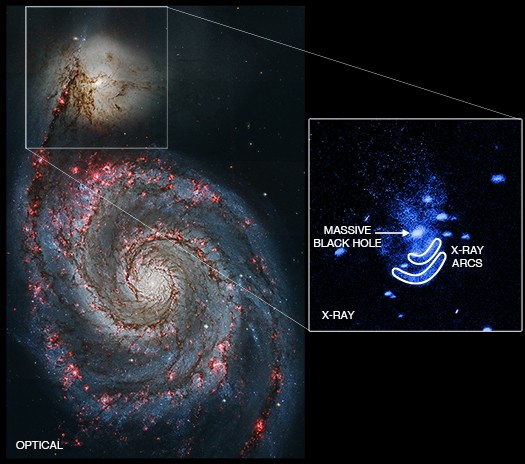Astronomers have detected a supermassive black hole that appears to be "burping" some cosmic material from the center of a galaxy, according to NASA. Some powerful X-ray emissions were observed by NASA's Chandra X-ray Observatory from this black hole located in the core of galaxy NGC 5195, which is some 25 million light years away from Earth.
This galactic disturbance is probably caused by the formation of new stars within said galaxy. Supermassive black holes devour much cosmic gas, dust or even whole stars that are within reach of the black hole's powerful gravitational forces. After swallowing celestial matter and stars, black holes can eject some gas remnants out to deep space.
According to co-author of the study, Christine Jones of the Harvard-Smithsonian Center for Astrophysics, two enormous blasts were expelled outward not inward this galaxy from an activity that can have a massive effect on a galactic landscape.
Black holes can determine or limit the size of a galaxy due to their incredible gravitational forces that can suck and destroy objects, cosmic entities and even whole stars and planets, where even light and sound cannot escape these galactic monsters. However, energy will escape from a black hole after they consume, that could heat up cold gas that is crucial for star formation.
In this new study, the supermassive black hole found in the center of galaxy NGC 5195 formed cool helium gas together from its gas emissions, leading to the formation of new stars. According to co-author of the study, Marie Machacek from the Harvard-Smithsonian Center for Astrophysics, black holes not only destroy but also create.
Scientists observed this smaller NGC 5195 galaxy enter a merger with a larger spiral galaxy known as NGC 5194 or "The Whirlpool". Chandra observed these changes during the merger, when the two galaxies interacted with each other, especially with the black hole of NGC 5195 leading to these powerful, x-ray galactic emissions.
According to lead author of the study, Eric Schlegel of the University of Texas, San Antonio, these new observations are pivotal since they offer a glimpse of what could have happened in the early stages of the universe that altered the evolution of galaxies.



























